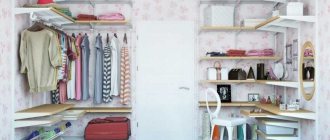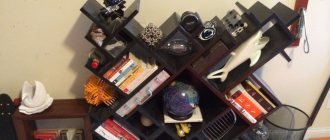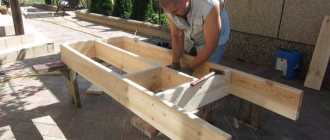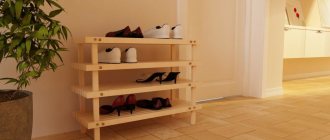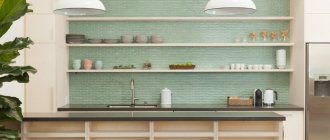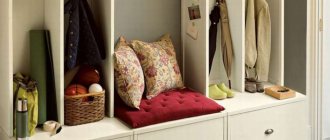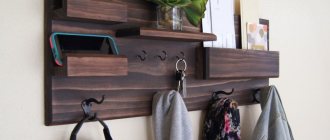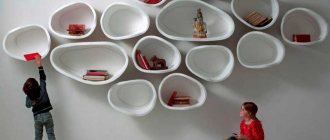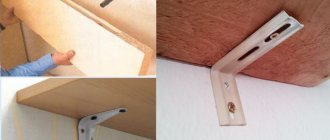= What shelves can be made from:
| made of wood Example: DIY flower shelves 230 | from metal pipes Example: DIY pipe shelves | from PVC pipes |
| made of cardboard Example: Shelf rack made of cardboard boxes | from paper | from plasterboard |
| from glass Example: Shelves in Art Nouveau style 180 do-it-yourself photos | from old boxes Example: DIY drawer shelves 120 photos | from pallets pallets |
| stainless steel | from glass | from old stairs |
| From bars | from bottles Example: Glass bottle shelves | from driftwood and branches Example: Bookshelf made of branches and driftwood |
| made of bricks Example: Bookshelves made of bricks and boards | from newspapers Example: Newspaper shelf | From cans Example: DIY kitchen shelves: 456 photos, drawings, instructions |
Main varieties
The design of rooms with functional, aesthetically pleasing shelves is actively gaining popularity.
This piece of furniture allows you to use space as efficiently as possible. Many people use it to create a unique style in the interior. On such shelves you can easily arrange various things so that they are always accessible, but the room remains in complete order. So, the following can be easily placed on the corner shelves:
- small household appliances;
- dishes;
- books;
- photos;
- souvenirs;
- personal hygiene items (if we are talking about the bathroom).
Corner shelves are often made from natural, environmentally friendly materials
If you decide to functionally use the corner area by choosing a corner shelf for it, you should carefully study the types of structures. There are a large number of them. The simplest ones consist of 2 supporting parts and a board screwed to them on top. Even a novice craftsman can create such furniture with a set of simple tools at hand.
Table 1. Types of corner shelves
| Variety | Description |
| It is distinguished by the presence of three supports on which horizontal parts are firmly fixed. Externally, the bookcase looks light and elegant. Can be complemented with openwork carving. |
| It is advisable to install it in internal corners. When designed correctly, it becomes a harmonious recess in the wall. Most often, plasterboard sheets are used to create niches. The material attracts: |
- affordable price;
- ease of work.
Open shelf
Characteristics of materials used
Furniture departments offer a wide range of shelves, which are made from a variety of materials. When choosing a specific name, it is worth starting from the three most important factors.
- Operating conditions for the presented design.
- Stylistics of the room.
- Future load on the shelf (the design may have a decorative or functional purpose).
We suggest you read: What to make shelves in the steam room from
Be sure to analyze these factors, and then make your final decision.
It is easy to place indoor plants and decorative items on a multi-level structure
Table 2. The most common materials from which corner shelves are made
| Material | Description |
| Natural wood | Instances made of wood always look expensive. The use of rare breeds is not widespread due to the high cost of the product produced. Such a shelf should completely match the style of the room. The designs look elegant: |
Specimens made from untreated wood look beautiful. They are most often used to design a rustic kitchen.
Many people make furniture from it themselves, using master classes posted on the Internet or taken live.
When making a structure yourself, you need to sand the edge well with sandpaper. This procedure will help remove:
You can give the finished product a presentable appearance:
Factory-treated plywood does not require a decorative coating.
If the design is being developed for the kitchen, it is necessary to use a moisture-resistant gypsum fiber sheet. PlasticThe presented material is most often used for bathroom shelves. It has undeniable advantages, including:
It is worth remembering that plastic is easy to break, but if only hygiene items are stored on the shelf, this will not be a critical drawback.
The material cannot be called fragile, especially if:
More often, metal elements are used to decorate glass and wooden shelves. They can also act as support posts between tiers of the structure.
Location and purpose of the structure
When choosing the size of the shelf and its type, consider in which room it will be located in the future. It is important to create a complete interior with a functional detail.
The main purpose of the shelf is to optimize space in the house
For the kitchen, it is important that all the necessary items are always at hand, and not hidden in numerous drawers. It is best to use a compact, yet spacious wall design. Wooden models are most suitable for the kitchen, as they create a cozy atmosphere. A variety of designs allows you to choose an option that harmoniously complements the interior of the room.
A good alternative to wood is decorated gypsum fiber sheet.
In a small kitchen, the shelf has a practical purpose, helping to keep necessary utensils in order.
Hallway
By using an original hanging shelf, you can easily decorate your hallway. Such furniture can easily perform several functions.
- A small shelf is suitable for storing keys and small items.
- The larger design allows you to easily accommodate all your bags.
- The tall design, complemented by figurines, will add sophistication to the hallway.
- The shelf with hooks is easy to use as a hanger.
For the hallway you should choose wooden furniture. Glass, metal and plastic cannot be called practical or universal. Take this into account when arranging the room.
A corner shoe stand will be a functional addition to the hallway
Bathroom
It's hard to imagine a bathroom without a convenient corner shelf on which all hygiene products are stored. Of course, numerous jars can be neatly stacked in a closet, but getting them out of it every time is not entirely convenient. It is better to have them at hand at all times.
For the bathroom they most often choose:
- glass structures with chrome stands;
- plastic shelves with metal racks.
It is important that such an interior detail is distinguished by its laconic execution. This makes it easy to care for, since high humidity in the bathroom causes rapid contamination of surfaces.
Manufacturers make the design as functional as possible by adding hooks, soap dishes
Living room
The living room is an ideal place where you can install a functional corner structure. Reading lovers will use shelving to store their home library. On the shelves you can easily place:
- family photos;
- decorative items.
During installation of the structure, you should definitely consider what load is planned on it. Fastenings must be as reliable as possible. Its size directly depends on the future purpose of the selected shelf. Decorative elements look good on compact models, and for a large library or collection, choose a spacious shelving unit.
Small corner shelves with carvings and shaped wooden details are often used as stands for icons
In many living rooms, wooden or metal corner shelves are used as flower stands. Glass specimens are much less common in living rooms. Designers advise not to clutter the shelves with numerous flowerpots and figurines. This eliminates the feeling of lightness that such a design is intended to add to the room.
In a spacious interior, options installed on external corners look harmonious. More often they are made of plasterboard or chipboard. You can design such an addition to the room yourself, taking into account the characteristics of the place chosen for the shelf.
For a small room it is better to purchase a compact design
Making a shelf yourself: how to decide on the design and materials?
Any wall shelf can have a different shape and design. They can be complex (with additional elements) or simple. Simple shelves can be used in the kitchen.
They are used to store seasonings or kitchen utensils, so there is no point in coming up with a complex design.
It’s very easy to make semicircular shelves. This option is ideal if you don’t have the time or desire to do something more complicated. Also, simple shelves can be used in apartments and houses decorated in minimalist styles.
Such styles do not welcome complex shapes and intricate designs.
Shelves with additional elements can be used in living rooms. They can consist of several sections, or have an unusual shape, for example, in the form of the letter “L”.
Often such furniture occupies not only a corner, but also some part of the wall.
You can decorate such furniture using an original cutting method, if you have experience in this matter. The shelves placed in the corner also differ in the presence of a back wall. It may be present or replaced by a wall. If you want to preserve the decoration of the walls, then it is still better to build a furniture wall.
It doesn't require much effort.
In this article we will look at the process of constructing a classic-shaped corner shelf. This form is very simple and versatile. It won't even take two hours to make.
To get started, you need to decide not only on the shape of the product, but also on the material.
Let's look at the types of materials and their advantages.
To quickly decide on raw materials, be sure to consider the comparative characteristics presented in the table.
| Characteristics | Materials | |||
| Tree | Plastic | Glass | Metal | |
| Aesthetics | + | + | + | +/- |
| Durability | + | — | + | + |
| Ease of processing | + | + | — | — |
| Price | high | low | high | low |
| Moisture resistance | + | +/- | + | — |
| High temperature resistance | + | — | + | + |
| Strength | + | — | +/- | + |
Having analyzed all the characteristics, you can see that it is simpler and easier to create a corner shelf from wood.
In this article we will look at detailed instructions for making such furniture.
Assembly of the finished product
For crossbars, rectangular pieces of chipboard of the same length are suitable. It is important to choose the right width: the shelf should not protrude beyond the vertical stand.
To give the design originality, the internal stand was additionally cut in two places to the depth of the shelf.
The shelf board will be inserted and secured into the slot.
First, the lower shelf and the outer stand are fastened with confirmations. For correct positioning, use a square or corner clamp.
At a distance of 8 mm from the edge, a hole is made using a confirmat drill; the second stage of the cutter should go no more than 2 mm deep.
After drilling, the parts are fastened with confirmat. Tightening must be done all the way until the joint between the parts disappears. A slight cracking sound when tightening is normal.
The next stage is to attach the internal vertical post at an arbitrary distance from the external one.
Then you need to install the top shelf. First it is attached to the outer stand.
We drill and fasten it with confirmations.
Please note: when drilling, you must keep the drill strictly perpendicular to the surface of the part, otherwise, after tightening the end.
The fastening of the top shelf to the internal rack was done in a rather original way. Even the elongated confirmations were not enough to fasten all three elements, so the groove was made by hand with drills.
For clarity, see the photo with the drills used, their diameters: 6, 7.5 and 10 mm.
First, a hole was made to the full depth with a 6 mm drill, then two countersinks were made: 7.5 mm for the head and 10 mm for the flange. The confirmat is screwed into the finished groove, which will now reach the array of the lower part of the rack.
The length of the Z-shaped wrench was not enough, so a longer L-shaped wrench was taken, extended for convenience with a regular bit holder.
Now all that remains is to secure the awnings. Black screws are not suitable for this - they can burst under load. However, they are convenient for making the first pass for more convenient screwing in furniture screws.
After gluing the decorative plugs, the shelves can be hung in place.
No additional fasteners were used at the corner connection, since the chipboard board has sufficient bending strength. But purely for aesthetic reasons, the shelves can be connected to each other with dowels or a metal plate.
Redrick Adlynx Shewhart, rmnt.ru
This is the simplest product that can be easily made with your own hands; drawings for it do not need to be designed on a computer; a drawing sketched with an ordinary pencil or pen will also work here. Any scraps can be used as material, so the cost of such an item will be very small.
How to make a corner shelf with your own hands?
- Our main material will be a regular board purchased at a hardware store. Its width in each case is selected individually, based on your plans.
- Additionally, we will take semicircular slats for decorating the shelf, PVA glue with a dispenser, and 3.0x25 mm screws.
- We mark our strip at an angle of 45° and saw it into blanks.
- We put the first piece against the wall, if everything is fine, then we need to make three more pieces.
- You can cut with a hacksaw, jigsaw or other convenient tool.
- In total we make four corner platforms and ten vertical racks for the shelf. Clean the surface with sandpaper.
- Let's start assembling the structure. You can attach the parts to the wall and figure out how everything will look in place.
- In the lower compartment of the shelf we will have 4 racks, in the middle - two racks, in the top row there are 4 more racks. We fasten the racks with screws, enhancing the quality of the assembly with PVA glue. We mark the board. To prevent it from cracking, we drill holes for the screws with a drill bit of a slightly smaller diameter than the diameter of the screw.
- The bottom of the shelf is ready.
- First, we screw the screws halfway into the bottom platform, then we coat the strip with PVA, wait a while (1-2 minutes) and finally tighten the parts with screws. Carefully wipe away any remaining glue.
- We assemble the remaining parts of our structure in the same way.
- We will decorate the shelf with elements cut from slats of a semicircular section.
- The DIY corner wooden shelf is ready. We attached decorative fences to prevent our things from falling, painted everything with gold paint, and installed the product in place.
Corner wall shelves are quite easy to make yourself. Such products serve well in the office, kitchen, and bathroom. You can place flowers, books, jewelry, and various trinkets on them. This thing is very functional and there is absolutely no need to buy it if you can make it yourself.
I have always dreamed of having such a corner with corner shelves for books and handicrafts. I found an interesting option, which is distinguished by its ease of creation, and also by its lightness and airiness of design. As it turned out, this is not at all difficult to do; for the work you will need a system of rail supports. The design of such a system, as in the photo below, consists of four metal vertical rail posts with brackets inserted into their slots or grooves. In stores you can find stands in different colors or with a protective coating. The design can support shelves made of different materials, natural and artificial. You can use both ready-made and homemade shelves. The racks can be easily rearranged even with shelves attached to them. Three or more racks allow shelves to be used in different lengths and at different levels, ensuring optimal use of available space
Below I suggest you familiarize yourself with the method of installing adjustable shelves, which you can make to your taste, of any size, of different designs. I don’t think it will be difficult to make such a corner structure; the main thing is to have a drill, brackets and stands on hand. And the shelves themselves can be ordered upon purchase; boards or chipboards can be purchased already cut to the required sizes. By the way, so that the shelves fit beautifully into the interior of your home, the racks and brackets can be decorated with forged elements, which can be ordered from. The company produces custom-made forged fences, forged gates and gates for a country house or plot based on an author's sketch. On the company's website you can view a photo gallery of very beautiful finished works.
So, the fasteners that hold the racks with brackets on the wall are subject to significant loads, so use additional fasteners. For solid brick or plaster walls, use screws at least 38mm long, driven into plugs that fit into the drilled holes. In partitions with a wooden frame, determine the locations of the vertical posts, located one from the other at a distance of 400 mm. Then screw 38mm long screws into the studs through the plasterboard. Hollow wall mounts can be used to hang shelves on plasterboard walls.
As with brackets designed for fixed-height shelves, the distance between the posts depends on the material of the shelves, their thickness and the expected load. With the simplest method of hanging shelves, their rear ends are spaced from the wall. To ensure that the rear ends fit against the wall, make cutouts in them. Having determined the locations of the posts and the distances between them, attach the first end post to the wall and use an awl to mark the position of its topmost screw. Drill a hole and, if necessary, insert a plug (see Helpful Hints). Screw in the screw halfway.
Apply a spirit level to the stand and position it strictly vertically. Mark the positions of the remaining screws and drill holes (insert plugs if necessary). Attach the stand to the wall.
To accommodate the second end post, insert the brackets into the slots at the same height in both posts. Place the shelf on the bracket of the first post, place a level on top and install the shelf horizontally. Press the second post against the wall, mark the position of the top screw and attach the shelf as described in paragraphs. 1×2.
Attach all intermediate posts. Insert the brackets into the slots in the posts. Check that they are placed correctly in height - the brackets of one shelf should be at the same level. If necessary, cut the shelves to length - the cut edges can be covered with veneer.
After placing the shelves on the brackets, align the ends of the shelves with a spirit level or plumb line.
If the shelves are not in a niche that makes them safer, it is better to attach the shelves to brackets. Drive the screws into the underside of the brackets while holding the top of the shelf with your other hand. The screws should not go deeper into the shelf than two-thirds of its thickness.
